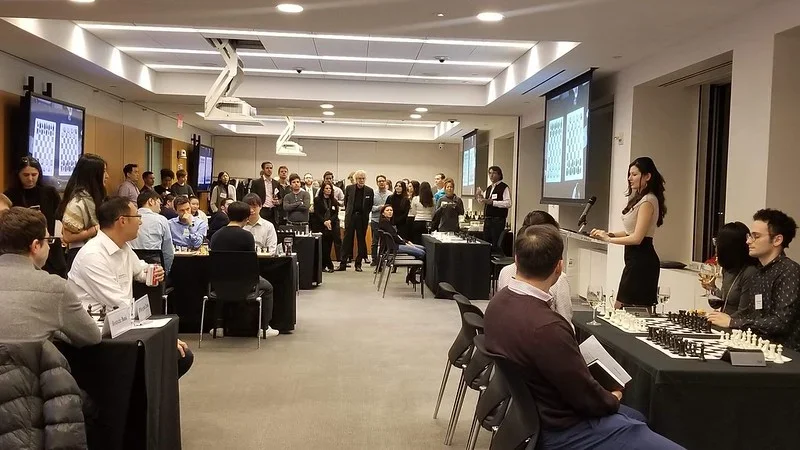
FM Alisa Melekhina discusses the transition of corporate team championships to online play during the COVID-19 pandemic. Her team, Debevoise & Plimpton LLP, hosted the first two OTB seasons of the NYC Corporate Chess League, then during lockdown competed in the inaugural FIDE World Corporate Online Team Championships in February, and the Corporate E-Sports Association Global Chess League this spring.
Before the COVID-19 pandemic shut down over-the-board (OTB) play last year, corporate chess was in full swing. The NYC Corporate Chess League had just concluded its second fall season, finishing on a high note with a highly anticipated closing ceremony.
The second NYCCL season built off the successful formula of its first season: six matches played on a bi-weekly schedule at the law offices of Debevoise & Plimpton LLP, between three-player teams hailing from eminent firms, banks, and corporations in New York City: Bank of America Merrill Lynch, Debevoise & Plimpton, Deutsche Bank, Goldman Sachs, Google, JPMorgan Chase, RBC Capital Markets and Two Sigma.
The NYCCL met with resounding success among the players, spectators, and guests, precisely because it offered the missing nexus between chess enthusiasts at corporate institutions, and a forum for sharing their passion for chess. The model of the NYCCL never had an entry fee or profit component. Rather, the players were eager to play for corporate pride, along with the opportunity to forge new connections both internally and externally.
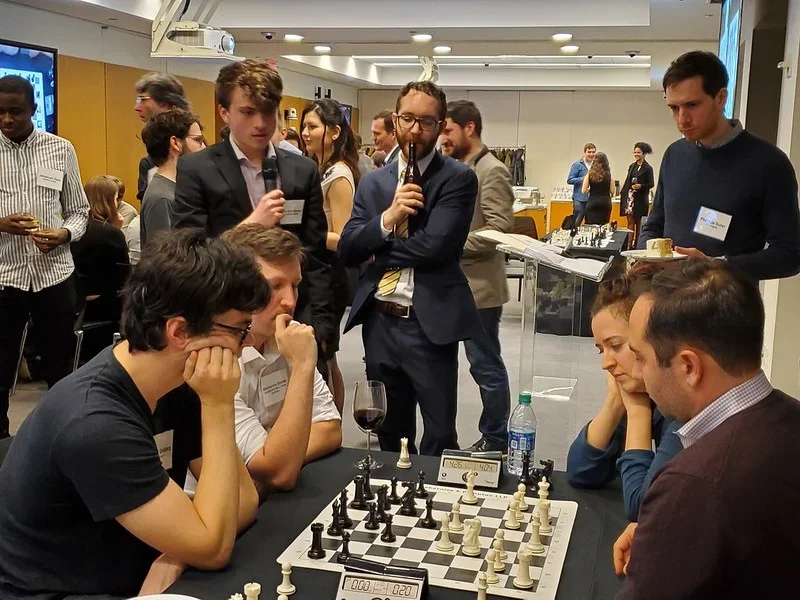
But when OTB play ceased, the future of corporate chess went up in the air. Sure, it was possible to schedule a few online matches here and there, but it would be impossible to replicate the lively corporate atmosphere – or so I thought.
I was pleasantly surprised that around the fall of 2020, the idea for an online corporate chess league had sprung up from several different organizers, each of whom independently saw the same silver lining opportunity: Taking corporate chess online offered scheduling flexibility for busy professionals and reinforced internal team building, during a time when remote work detracted from in-person interaction. Further, it allowed the opportunity to loop in colleagues from global offices who would otherwise never participate in local OTB events.
After conferring internally with my team at Debevoise & Plimpton LLP, we saw the value proposition and were on board.
“Debevoise is proud to continue its support of the corporate chess community by participating in the online chess leagues during the pandemic,” said Debevoise corporate partner Andrew M. Ahern. “Playing online has enabled a Debevoise team composed of lawyers and staff across departments and offices to join together in a way that would have been impossible with strictly in-person competition.”
FIDE World Corporate Online Team Championships
The first online competition Debevoise entered was the inaugural FIDE World Corporate Online Team Championships, February 19-21, 2021. Naturally, the prestige of having the governing international chess body of FIDE back a world championship event was a major draw. Personally, I also appreciated that it was played over the span of a single weekend, which made scheduling around the matches easier.
The FIDE event used a 10+2 time control, with a single game played during each team match-up. There were three matches scheduled on each Friday and Saturday, with the top-finishing team from each division advancing to Sunday playoffs. Due to our assigned time zone, the western conference games were played from 8:30 p.m. ET until around 12:30 a.m.
FIDE had clearly put a lot of thought into the team composition and scheduling logistics before the event. They used similar rules as the 2020 online Chess Olympiad structure, with each team required to have at least one female player. Having strong female representation was not an issue with the NYCCL teams, with half the team captains as women and a strong female turnout on the top boards.
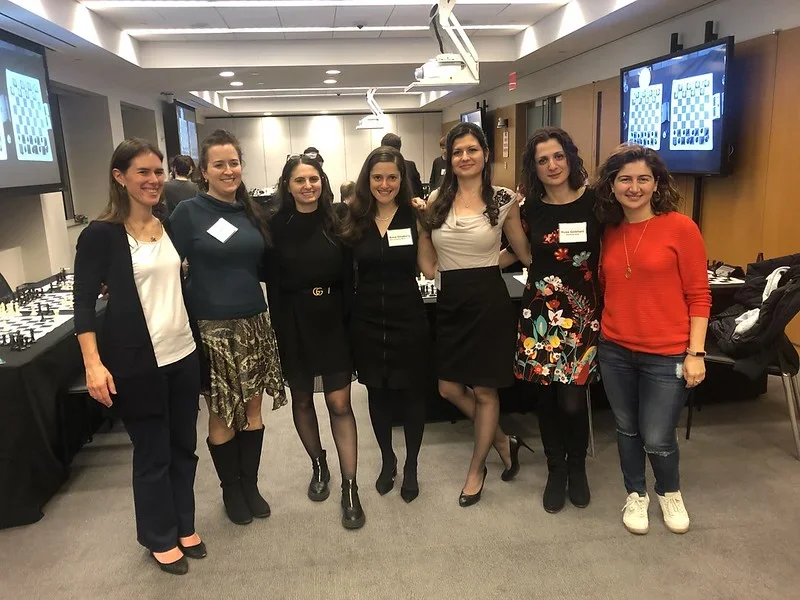
My initial concern with FIDE’s female requirement was that teams would circumvent this rule by listing a female as a reserve, but never play her in the event. However, the FIDE organizers assured me — and in fact updated their rules to make this explicit — that a female player was required to be on the main four-player team composition for each round.
Impressive was FIDE’s quick and thorough responsiveness in fielding questions from multiple teams. Given this was an inaugural event with novel team and tech requirements, the multitude of questions and concerns the organizers had to address were no doubt plentiful, and their attention to detail translated into a smooth handling of the matches themselves.
Players were required to be on Zoom at least 30 minutes before the round. During the game, pursuant to the Fair Play measures, everyone’s webcam, microphone, and screen-share all had to be turned on simultaneously. Initially the tech requirements were intimidating, but eventually we got used to it and forgot Zoom was even on.
FIDE deployed a far-reaching staff of international arbiters devoted to the event, including an arbiter assigned to each breakout room to oversee tech and pairing issues, and other organizers on standby in busy WhatsApp group chats to answer questions.
In lieu of official entry fees, the FIDE event encouraged corporate donations to FIDE’s non-profits: the Chess Veterans Support program and the Chess in Education programs for kids.
As incentive, FIDE gave away a special VIP package to the 2021 World Chess Championships in Dubai to the corporate team which raised the most, with an online simul against Russian GM Ian Nepomniachtchi as the winner of the 2021 FIDE Candidates Tournament. This incentive arguably exceeded the official prize awarded to the top-four finishing teams.
The prestige of the event, coupled with a low barrier to enter, was among the factors that resulted in a massive registration of 288 total teams from 78 different countries. FIDE allowed each team one player from outside of the company, which resulted in the participation of the world’s chess elite, including GM Anish Giri, who played for Optiver, and Nepomniachtchi, who played for Sberbank. Notably, World Champion Magnus Carlsen himself participated on behalf of Kindred Group, one of his corporate sponsors.
The Debevoise team included myself on the top board, our senior tax associate attorney David Rock, and two newcomers, litigation associate Erik Rubinstein and litigation analyst Bas Munnik. We were rounded out by our seasoned outside player, GM-elect Raja Panjwani. Corporate staff attorney Aleksei Romanovski served as co-captain.
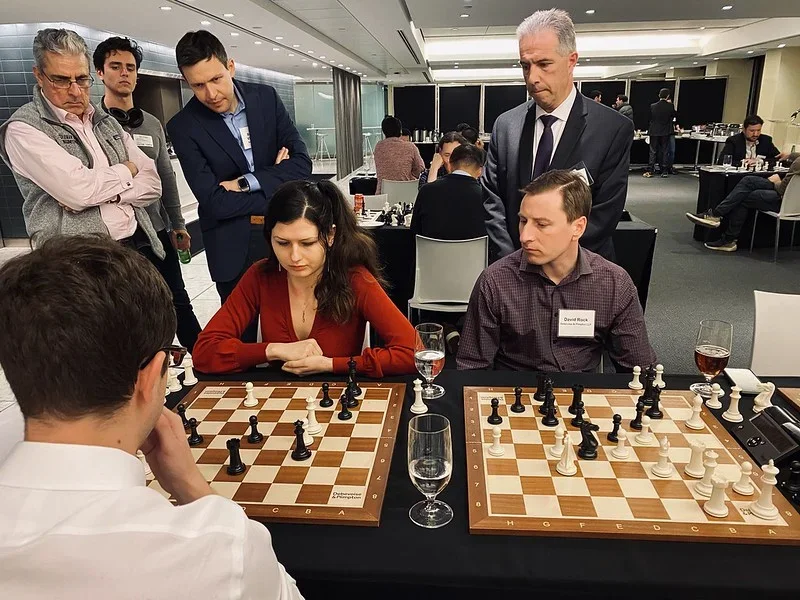
The western conference division featured well-known companies such as Microsoft (Redmond), Amazon, Deloitte, and Workday. Debevoise was even paired against its fellow NYCCL team, Goldman Sachs in round two.
“While it has been challenging more recently to facilitate over the board chess, this past year has presented a unique opportunity to bring more chess enthusiasts together online in a way that’s easily accessible. We’ve actually seen interest in the game explode,” said Alexandra Wiener, the team captain of Goldman Sachs and co-founder of the NYCCL. “At Goldman specifically, I’m proud that the team has continued its momentum off the back of winning the NYCCL in 2019, by putting up a good, competitive fight in the recent (and first of its kind) online World Corporate Chess Championships.
“I’m equally proud of the work the team’s been able to facilitate off the board — where we’ve built upon the community-building started by the NYCCL, and have focused our internal efforts on fundraising and volunteering with Chess in the Schools, a non-profit focused on using chess as an education tool to support low-income youth.”
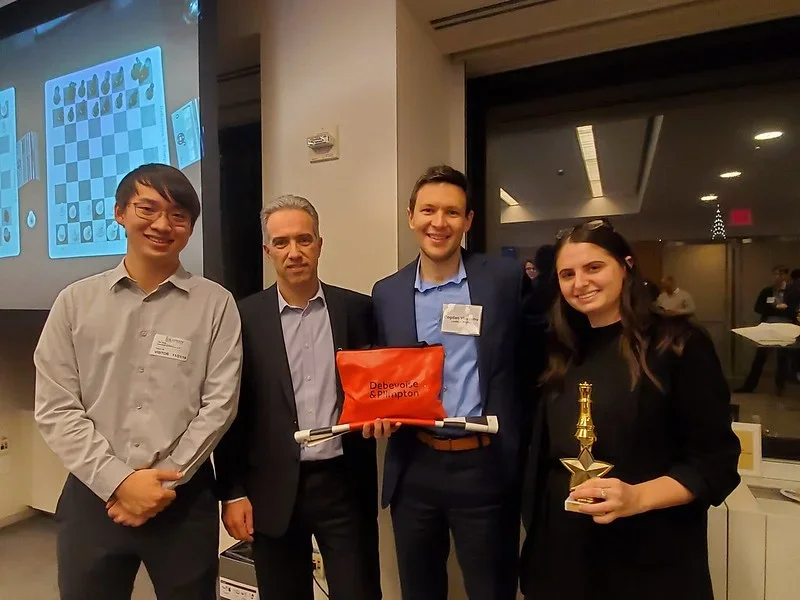
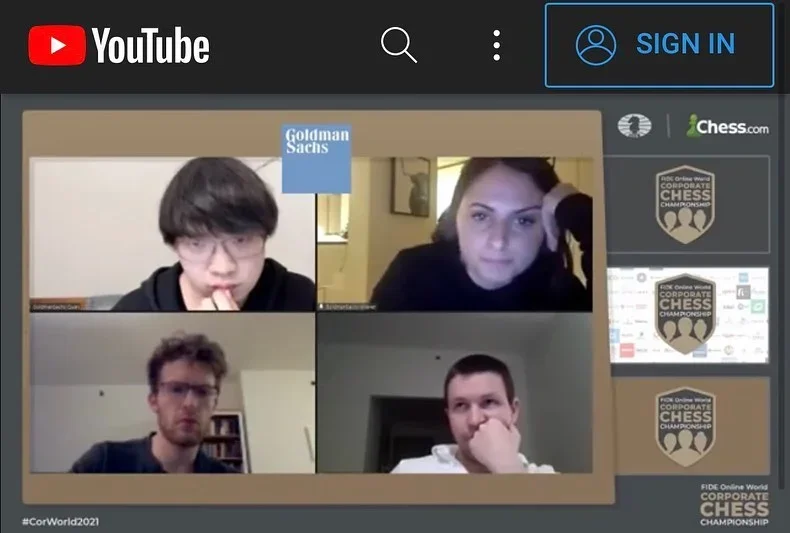
Although I am still getting used to rapid time controls and online play, I did manage to get a serious game in my pet Advance French gambit line, which I have covered extensively in Chess Life:
[pgn][Event "FIDE World Corp Team Champs"] [Site "Chess.com"] [Date "2021.02.21"] [Round "5"] [White "Alisa_Melekhina, FM.."] [Black "Gowtham13"] [Result "1-0"] [ECO "C02"] [Annotator "FM Alisa Melekhina"] [PlyCount "57"] [EventDate "2021.??.??"] [WhiteTeam "Debevoise (USA)"] [BlackTeam "Intel Microelectronics (Malaysia)"] [TimeControl "600+2"] 1. e4 e6 2. d4 d5 3. e5 c5 4. c3 Nc6 5. Nf3 Bd7 6. Bd3 Qb6 7. O-O cxd4 8. cxd4 Nxd4 9. Nbd2 {This spin-off variation of the Milner-Barry gambit, which does not have an official name, is my my pet gambit line in the Advanced French. I covered it previously for Chess Life magazine (10/2015) and chess.com.} Nc6 { This may appear to be consolidating, but is not the most challenging way to play against the gambit. White's pieces quickly spring into action, and the knight on c6 becomes a thorn in Black's side.} (9... Nxf3+ 10. Nxf3 Bc5 { Accelerating development, is a more critical line.}) 10. Nb3 {The point of the line. Without the d4 pawn, Be3 targets black's queen. From b3, the knight controls both d4 and c5, which presents problems for black's lagging development.} Nge7 11. Be3 Qc7 12. Rc1 Ng6 13. Re1 Be7 (13... Ngxe5 {Of course, black is hesitant about walking into yet another pawn sacrifice. However, he has to face white's challenge head on. (Which is why this opening is so effective againt French players who would rather play their quiet French structures). If black never captures the e5 anchor in white's position, black's position will implode, as happened in the game.} 14. Nxe5 Qxe5 15. Nc5 $44 (15. Bxa7 $2 {not the right time to be thinking about pawns; black comes out ahead in the pawn count anyway. White's momentum has fizzled out.} Qxb2)) 14. Nc5 O-O 15. b4 {This set-up with Rc1, Nc5, and b4-b5 is thematic against the Nc6 retreat.} a6 16. a4 b6 (16... Rfc8 {Black needs to sit tight and hold on. For example,} 17. b5 $2 {is not decisive, as black is covered against all possible discoveries.} Ncxe5 $1 18. Nxe5 Nxe5 (18... Qxe5 19. Nxd7) 19. Nxe6 ( 19. Bf4 Bxc5 20. Bxe5 Qb6 $19) 19... Qd6 $1 20. Rxc8+ Rxc8 21. Nd4 Nxd3 22. Qxd3 $17) 17. Nxa6 Qb7 $2 (17... Qd8 {Black's last chance to keep the game balanced, again taking advantage of the loose e5 pawn.} 18. b5 (18. Bd2 $14 { is forced to protect both b4 and e5.}) 18... Ncxe5 19. Nxe5 Nxe5 20. Bxb6 Qxb6 21. Rxe5 Rfc8 $13) 18. b5 $1 Rxa6 {objectively not the best continuation. Understandably, however, black is facing a dilemma as to where to retreat the knight, and opts to attempt to sac the exchange. Unfortunately, even this attempt is unsuccessful due to black's Queen being overloaded.} (18... Ncxe5 { right when black needs it, this capture is finally no longer possible because} 19. Nxe5 Nxe5 20. Rc7 {surprise! The queen is trapped.}) 19. bxc6 Bxc6 20. Bxa6 Qa8 (20... Qxa6 21. Rxc6) 21. Bb5 Bxb5 22. axb5 {after the dust settled, I had to do a perfunctory piece count to confirm that I indeed came away with an entire rook up.} Bb4 23. Re2 Qb7 24. Rc6 Ba5 {With this retreat, black's bishop is completely out of play as well.} 25. Rec2 Qb8 26. Bd4 Ne7 27. Rc7 Nf5 28. Qc1 h6 29. Rc8 {Black resigned as the last straw is losing the queen.} (29. Rc8 Qb7 30. Rxf8+ Kxf8 31. Rc8+ Ke7 32. Rc7+) 1-0 [/pgn]
Our first-round jitters wore off as the games progressed and, by the second day, we were comfortable with the format. The stringent Zoom requirements, fixed round times, presence of arbiters, and the caliber of the players helped replicate a true OTB tournament atmosphere – almost to the point where I was preparing before the matches and analyzing afterwards late into the night, as if I were in tournament mode. Because the standings were calculated by total game points (as opposed to team match points), every result on every board counted. Out of 26 teams in the Western division, Debevoise finished tied for sixth with 13.5/24.
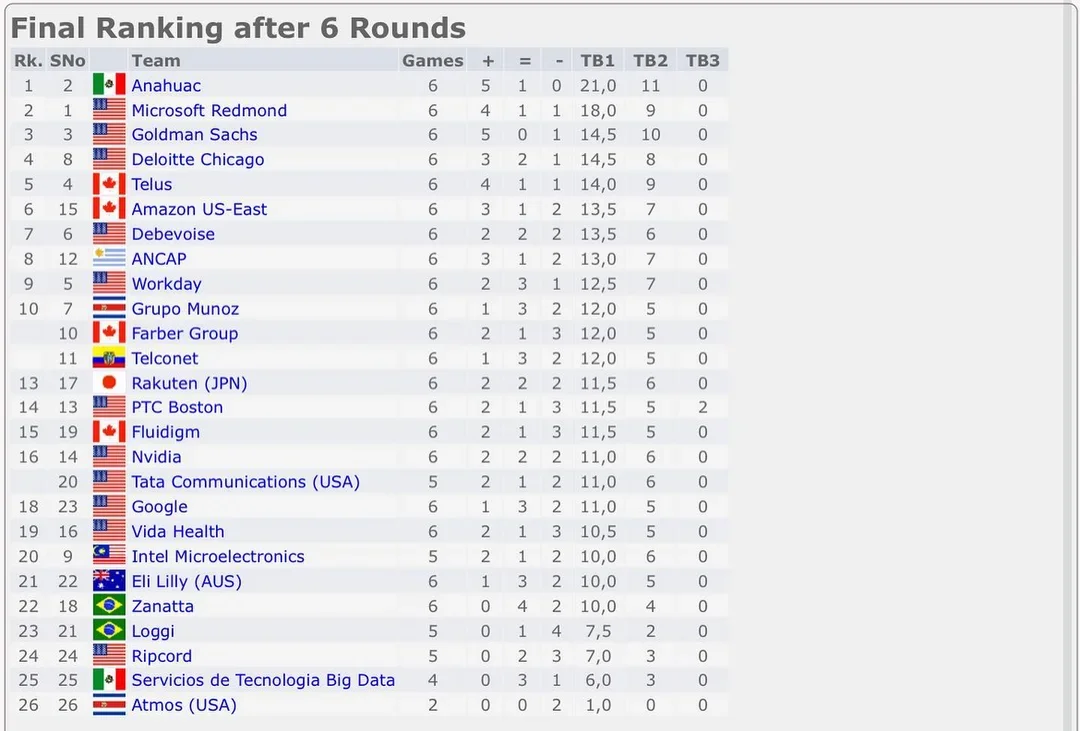
The winner of FIDE’s World Corporate Online Team Championships was Grenke Bank AG, headquartered in Baden-Baden, Germany and spearheaded by power couple GM Georg Meir and WIM Inna Agrest.
CEA Global Chess League
Though Debevoise did not advance to FIDE's playoffs, the event prepared us well for a second league in which we participated: the inaugural season of the Corporate E-Sports Association (CEA) global online chess league. Playing weekly from mid-February to mid-May 2021, the prolonged duration of this league intended to encourage friendly and sustained team participation during the spring season.
As webcams are not required, the CEA league depends on an honor system of abiding by the Fair Play standards. League games were played with a 7+2 time control, with a twist that everyone plays everyone on the four-player teams. The rule eases the strain of selecting precise board requirements when players’ online ratings may not be a reliable indicator of strength or are in constant flux. The winning team of each match is determined by the most points out of 16 possible game points. As the games went quickly, the players were eager to play more chess and appreciated the opportunity to fit in four serious games in quick succession. We found that, with no tech issues, an entire match ran under 1.5 hours.
The CEA league is co-organized by the Washington State Chess Federation and by Florian Helff, a Twitch Software Development Engineer II and head of the Amazon Chess Club. Given the West Coast presence, the CEA league’s participants included powerhouse companies such as Amazon, Boeing, Facebook, Twitch, and Microsoft.
“I've personally been involved with CEA’s League of Legends tournaments for the past few years playing for Twitch and Amazon, and greatly enjoyed them,” Helff said. “The way that CEA uses games as a platform of common interest to promote networking and charity offers a lot of opportunities, and I proposed to the CEA to expand to chess for the Spring 2021 season.
“Using a tournament format and chess community I have been building locally in Seattle, and taking it to a national level, was a big step but it has paid off so far. The CEA Chess community is already one of the biggest charitable contributors across the whole CEA.”
The CEA league is a not-for-profit enterprise. With 36 teams entered in this inaugural season and an entry fee of $160 per team, the prize pool of nearly $6,000 will be allocated according to charities chosen by the top-three placing teams. Debevoise is proud to be playing for the USCF Women in Chess Initiative, which encourages female participation and retention in chess.
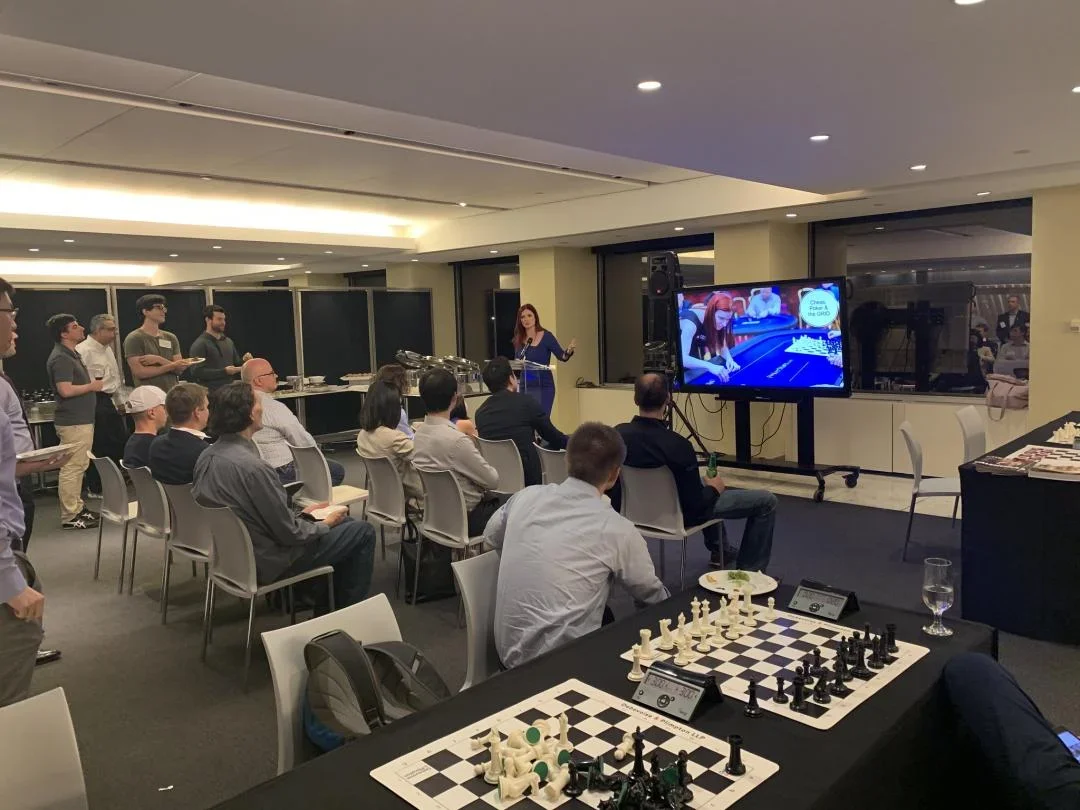
I have been impressed with the responsiveness of the CEA organizers and their commitment to ensuring that all match format requirements are as flexible as possible for busy corporate players, while preserving the integrity of the game. (The detailed CEA league rules are available here). The organizers even built out a custom, private tournament portal for issuing game challenges on chess.com, recording game results, and updating the pairings and standings.
The CEA playoffs are in a knockout format spanning April through May, with a match default time of Saturdays at 1:00 p.m. ET. A major draw of the league is being able to reschedule the match for any point during the week: We tend to prefer weekday evening matches and were pleased to find many of the teams amenable to rescheduling. Each week, a featured match or two is broadcast live on the CEA Twitch channel, with coverage by streamers such as WCM Liza McDonald, IM Alex Banzea, and a secondary broadcast by “Coach Ryan” Ackerman.
[pgn][Event "CEA Global Chess league - Playoffs rd 1"] [Site "Chess.com"] [Date "2021.04.17"] [Round "?"] [White "(rockistired) Rock, David"] [Black "caelym123"] [Result "1-0"] [ECO "B01"] [Annotator "FM Alisa Melekhina"] [PlyCount "37"] [EventDate "2021.??.??"] [WhiteTeam "Debevoise"] [BlackTeam "Pocket Gems"] [TimeControl "420+2"] 1. e4 d5 2. exd5 Qxd5 3. Nc3 Qa5 4. d4 Nf6 5. Bd2 c6 6. Nf3 Bf5 7. Be2 { Up to this move, the Scandinavian has proceeded in a typical manner. The Bishop is usally placed on c4, however. From there it controls d5 and sets up batteries over the f7 and e6 weaknesses. It would also support a viable Nd5 discovery on the queen. However, it is not unheard of to place the Bishop on e2 in more conservative lines. Black lacks any direct targets.} e6 8. a3 { An interesting prophylactic idea to stop black from playing Bb4 and intervening with the Bd2-Nc3 battery. However, it is not strictly necessary. a3 is always possible to play afterwards; black is loathe to exchange the Bishop for the knight on c3, which has moved only once, and would allow white's dark-squared bishop to step into the game with a tempo.} Nbd7 9. O-O c5 $2 {Right idea, but played at the wrong time. In general, black should be aiming for e5 or c5 breaks against this structure in the Scandinavian. However, these are more likely to be successful when black's pieces are developed and are ready to support any counter-strikes. In playing this break so soon while black's king is still stuck in the center, the plan horribly backfires.} ({ White correctly continues with completing his development. Black needs to follow suit, by first re-routing his Queen to a safer diagonal. For example:} 9... Qc7) 10. Nb5 {Although this does not yet lead to a forced win, white has a pressing advantage. Nb5 seizes the opportunity to finally discover the queen and place black in an uncomfortable situation where he has to find precise moves just to stay alive.} Qd8 $2 (10... Qb6 {would put up slightly more resistance, although still leading to a bleak outcome.} 11. dxc5 Bxc5 12. b4 Be7 13. Be3 Qd8 14. Bxa7 O-O 15. Bd4 $16) 11. Bf4 $1 {Piling up on the exposed dark-squared weaknesses in black's camp.} Rc8 (11... Nd5 {was a better defense of c7.} 12. Bg3 a6 13. c4 axb5 14. cxd5 c4 $16 {Black has to find tough intermediate moves such as this to avoid the center falling apart. He is still worse at the end of this either way.} (14... exd5 15. dxc5 Bxc5 16. b4 Be7 17. Qxd5 Be6 18. Qxb7 $18)) 12. Nxa7 Ra8 13. Nb5 Nd5 {We're back to the same option as in move ...11, except black is down the a7 pawn and has even more dark-squared weaknesses as a result.} 14. Bg3 cxd4 $2 {This only allows White's second knight to come crashing into the center, with a tempo attacking the f5 Bishop to boot.} 15. Nfxd4 Bc5 16. Nxf5 exf5 17. Nd6+ (17. Qxd5 { Is just a clean win of a piece and objectively the strongest continuation. White's position is so strong, however, he decided to go for mate with little downside. It's always nice when there are multiple winning options to choose from!}) 17... Bxd6 18. Bxd6 N7f6 {The final and decisive error, which makes this game a miniature.} (18... Ne7 {The last way to hold on for just a bit longer, but there is no way to avoid at least a piece loss.} 19. Bb5 O-O (19... Ra5 20. Bxe7 Qxe7 21. Re1 $18) 20. Bxe7 Qxe7 21. Qxd7 $18) 19. Bb5+ $1 { Black resigned as White's two bishops dominate. Black cannot avoid losing at least the Queen.} (19. Bb5+ Nd7 20. Re1+ Ne7 21. Rxe7+ Qxe7 22. Bxe7 Kxe7 23. Qxd7+ {[%eval 32756,0]}) 1-0 [/pgn]
[pgn][Event "CEA Global Chess League"] [Site "Chess.com"] [Date "2021.02.25"] [Round "2"] [White "QJAX"] [Black "Alisa_Melekhina"] [Result "0-1"] [ECO "B06"] [Annotator "FM Alisa Melekhina"] [PlyCount "60"] [EventDate "2021.??.??"] [WhiteTeam "Microsoft"] [BlackTeam "Debevoise"] [TimeControl "420+2"] 1. e4 g6 2. Nc3 Bg7 3. f4 c6 4. Nf3 d5 5. e5 f6 6. d4 Qb6 7. Rb1 {If white plays Rb1 in this line, then black can consider the opening a success. Typically, Na4 is the way to relieve the pressure on the b2 pawn.} (7. Na4 Qa5+ 8. c3) 7... Bg4 8. Be2 Nh6 9. h3 {ill-timed. Black intends to capture on f3 anyway to pressure d4. Further, once the Black knight springs to f5, g3 becomes a sore spot in white's camp.} Bxf3 10. Bxf3 Nf5 11. Ne2 {the only way to protect the pawn. Now white can't retreat the bishop. While white would like to kick the knight back with g4, this allows Nh4, and the knight will definitely not get trapped.} O-O 12. c3 (12. g4 Nh4 13. O-O fxe5 $19) 12... Na6 13. e6 $2 {When a side rushes to release the tension in the center with an optimistic pawn push, it often backfires. This is the dream turn of events when playing a hypermodern opening. What has been provoked into overextending; now the black knights have free range.} (13. h4 $1 {the computer favors this counter-intuitive move, which regains some control. White renewed the real threat of g4. Otherwise, it is difficult for white to find a meaningful continuation.}) (13. O-O fxe5 14. fxe5 Bxe5 $17) 13... Nc7 14. g4 Nh4 15. Ng3 Nxe6 {White simply did not have enough time to defend the pawn.} 16. f5 { This isn't a bad try to create some counterplay and open up black's king. Unfortunately, it overlooks a strong response taking advantage of the now open b8-h2 diagonal.} Qc7 $1 (16... gxf5 17. Nxf5 Nxf5 18. gxf5 Ng5 19. h4 $132) 17. Kf2 Ng5 18. Bg2 e6 $19 {Suddenly, white is on the defensive as black easily pries open the center.} 19. fxg6 hxg6 20. Qd3 e5 {the pawns begin to roll down, unobsructed.} 21. Rf1 e4 22. Qe3 Bh6 {Bringing all pieces into the game.} 23. Qe2 f5 24. Bxg5 Bxg5 25. gxf5 e3+ {this pawn has come a long way!} 26. Kg1 Qxg3 27. fxg6 {White is already irrevocably lost. This leads to a forced mate in 6.} Rf2 28. Rxf2 exf2+ 29. Qxf2 Be3 30. Rf1 Qxg2# {It's not every day you get to execute a mate on the board in 30 moves.} 0-1 [/pgn]
After completing seven regular season weekly matches, Debevoise finished a solid ninth place and sailed into a postseason for the top 24 teams, though we just missed out on a first-round bye given to the top-eight teams.
We won our first playoff match and advanced to a 16-team bracket. From there, we won again by the slimmest of margins, needing an additional tiebreak match of 5+2. As one of eight teams remaining, we were paired against the top team in the league – the Amazon Aardvarks. With only six titled players in the CEA league, the Aardvarks alone boasted three of those titles: GM Mauricio Flores, WGM Shrook Wafa, and FM Matthew Hassen. (The other titled players were GM Francesco Rambaldi with Microsoft, FM Thomas Ulrich with Facebook, and myself.)
Alas, this matchup was the final showing for team Debevoise. Given the all-play-all format, we could not keep up with the points amassed by the titled players. But if we were to get knocked out, we were glad to bow out honorably against the highest-ranked team.
Next Steps for Corporate Chess
Both the FIDE and CEA championships were played on Chess.com, which provides an accessible and intuitive platform for organizing internal corporate tournaments. First, nearly all members already had a Chess.com account going into the season, which substantially decreased the learning curve. In fact, many of the Debevoise team players collectively had tens of thousands of online games already under their belts – though I, coming exclusively from OTB play, had a lot of catching up to do.
We expect that online corporate team play is here to stay, in some form. Exactly how and to what extent remains to be seen. My overall impression is that even though there were some losses in corporate participation, this year of online corporate team play opened up competition to a new audience, and further highlighted novel avenues that should be considered part of an overall corporate team culture. I am hopeful that the new interest and online features explored this year will continue into a bright future for corporate chess.
Helff adds: “Chess is off to a great start with the CEA, and plans for summer and fall seasons to further grow the corporate chess community are in the works. The CEA believes in chess as a platform to not only play a couple fun games, but also use this common interest to make meaningful connections within your own company and among the other competing companies. This is also a main reason why our tournaments are played as true team competitions and not by accumulating individual scores. Looking back at the successful spring season and hearing many anecdotes from people networking has us motivated even more to create awesome content in the future.”
You can catch the CEA league final match this Saturday, May 15 at 1:00 p.m. ET, live with coverage streaming on the CEA Twitch!
FM Alisa Melekhina is a World Team Championship gold medalist and long-time competitor in US open tournaments and women’s national and world team invitational events. She graduated from the University of Pennsylvania Law school in May 2014 and is currently practicing as a corporate litigation attorney in NYC. She previously wrote a popular CLO article on Balancing Law School and Chess.
For further updates on corporate chess leagues, follow Alisa on Twitter and LinkedIn.
Categories
Archives
- January 2026 (8)
- December 2025 (27)
- November 2025 (29)
- October 2025 (39)
- September 2025 (27)
- August 2025 (29)
- July 2025 (43)
- June 2025 (25)
- May 2025 (24)
- April 2025 (29)
- March 2025 (29)
- February 2025 (20)
- January 2025 (24)
- December 2024 (34)
- November 2024 (18)
- October 2024 (35)
- September 2024 (23)
- August 2024 (27)
- July 2024 (44)
- June 2024 (27)
- May 2024 (31)
- April 2024 (51)
- March 2024 (34)
- February 2024 (25)
- January 2024 (26)
- December 2023 (29)
- November 2023 (26)
- October 2023 (37)
- September 2023 (27)
- August 2023 (37)
- July 2023 (47)
- June 2023 (33)
- May 2023 (37)
- April 2023 (45)
- March 2023 (37)
- February 2023 (28)
- January 2023 (31)
- December 2022 (23)
- November 2022 (32)
- October 2022 (31)
- September 2022 (19)
- August 2022 (39)
- July 2022 (32)
- June 2022 (35)
- May 2022 (21)
- April 2022 (31)
- March 2022 (33)
- February 2022 (21)
- January 2022 (27)
- December 2021 (36)
- November 2021 (34)
- October 2021 (25)
- September 2021 (25)
- August 2021 (41)
- July 2021 (36)
- June 2021 (29)
- May 2021 (29)
- April 2021 (31)
- March 2021 (33)
- February 2021 (28)
- January 2021 (29)
- December 2020 (38)
- November 2020 (40)
- October 2020 (41)
- September 2020 (35)
- August 2020 (38)
- July 2020 (36)
- June 2020 (46)
- May 2020 (42)
- April 2020 (37)
- March 2020 (60)
- February 2020 (38)
- January 2020 (45)
- December 2019 (34)
- November 2019 (35)
- October 2019 (42)
- September 2019 (45)
- August 2019 (56)
- July 2019 (44)
- June 2019 (35)
- May 2019 (40)
- April 2019 (48)
- March 2019 (61)
- February 2019 (39)
- January 2019 (30)
- December 2018 (29)
- November 2018 (51)
- October 2018 (45)
- September 2018 (29)
- August 2018 (49)
- July 2018 (35)
- June 2018 (31)
- May 2018 (39)
- April 2018 (31)
- March 2018 (26)
- February 2018 (33)
- January 2018 (30)
- December 2017 (26)
- November 2017 (24)
- October 2017 (30)
- September 2017 (30)
- August 2017 (31)
- July 2017 (28)
- June 2017 (32)
- May 2017 (26)
- April 2017 (37)
- March 2017 (28)
- February 2017 (30)
- January 2017 (27)
- December 2016 (29)
- November 2016 (24)
- October 2016 (32)
- September 2016 (31)
- August 2016 (27)
- July 2016 (24)
- June 2016 (26)
- May 2016 (19)
- April 2016 (30)
- March 2016 (36)
- February 2016 (28)
- January 2016 (32)
- December 2015 (26)
- November 2015 (23)
- October 2015 (16)
- September 2015 (28)
- August 2015 (28)
- July 2015 (6)
- June 2015 (1)
- May 2015 (2)
- April 2015 (1)
- February 2015 (3)
- January 2015 (1)
- December 2014 (1)
- July 2010 (1)
- October 1991 (1)
- August 1989 (1)
- January 1988 (1)
- December 1983 (1)







